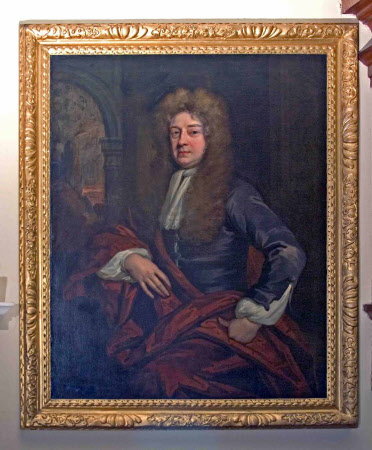Possibly Colonel William Windham I, MP (1647-1689)
Sir Godfrey Kneller (Lübeck 1646 - London 1723)
Category
Art / Oil paintings
Date
1680 - 1689
Materials
Oil on canvas
Measurements
1225 x 985 mm
Order this imageCollection
Felbrigg, Norfolk
NT 1401198
Caption
This portrait was traditionally, but impossibly, called Sir James Ashe, 2nd Bt. (1674-1733), but the sitter here clearly shows someone double his age at the time this was painted. It is most probable that it shows Ashe’s father, William I Windham, in his last years.
Summary
Oil painting on canvas, Possibly Colonel William Windham I MP (1647 - 1689) by Sir Godfrey Kneller (Lübeck 1646/9 - London 1723), 1680s. A three-quarter-length portrait of a man in a chestnut cloak over state dress, turned to his right. Behind is a landscape view through an arch. Traditionally, but impossibly, called Sir James Ashe, 2nd Bt (1674 - 1733), this was painted by Kneller in the late 1680's, around the same time as his portrait of Ashe Windham (1673 - 1749) in the Dining Room, but clearly shows someone double the age of either of them then. Most probably, therefore, of Ashe's father, William Windham I, in his last years. Typed label on back from RWKC 1955 - portrait is James Ashe of whom a portrait is mentioned in 1764 inventory of Felbrigg Pictures, or it is by Kneller of William Windham 1647 - 1689. Colonel Wiliam Windham I was the son of Thomas Windham and Elizabeth Mede. William went into the Army, lost a leg at the Battle of Blenheim (1704), but continued to campaign in the rest of the War of the Spanish Succession, finally retiring as Colonel. In 1705 he married Anne Tyrrell, daughter of Sir Charles Tyrrell of Heron Manor, Essex, and at first lived in Braxted in the same county, along with his mother. Unlike his mother and his younger brother James, he came well out of the South Sea Bubble, and was able in 1721 in buy Earsham from its amateur architect, John Buxton, who afterwards boasted that he had been paid "for every nail in it".
Full description
The identification is uncertain. In the Felbrigg Catalogue it is identified (i) as William Windham (1647-89); (ii) as Mr Dobyns, father of Mrs. Ash Windham, [a portrait of whom is recorded in the 1764 inventory (First Room), originally as unknown, but corrected to 'Mr Dobbins' - the 1771 inventory is left unaltered as >unknown'] and (iii) as Sir James Ashe, 2nd Bt., (recorded in the 1771 inventory). W. Ketton Cremer inclined to the last, and his was the identification previously adopted. Dated (recorded in F.C.) by David Piper as not earlier than 1690. Were this to be the case the first hypothesis would be ruled out, for William Windham died in 1689. Oliver Millar formerly confirmed that it is a portrait of c. 1695, but Malcolm Rogers (on the basis of a photograph), subsequently, did not rule out its being as early as 1689. If this portrait really dates from c.1690-95, with a terminus post quem of 1690, it is indeed difficult to see whom it might be of. The age of the sitter rules out Sir James Ashe - as one only has to look at the contemporaneous portrait of the one year older Ashe Windham +20, to see. >Mr. Dobyns' also seems an unlikely candidate, if - as seems the only likelihood - this was Elizabeth Dobyns's father, since she was born in 1693, so that one would expect him to only to have been born some 20-30 years before that - and anyway, the portrait at one point identified as his was the one over the chimneypiece of the Dining Room. No, in view of the great similarities, both of style and of features, between this portrait and +20, it does seem most probable that they are father and son, painted at the same epoch. Since +20, seems always to have been identified as Ashe Windham, that makes this the portrait of William Windham I (and the fact that Ashe's portrait was painted before his father's death would help to explain there being no payment for it noted in his mother's account-books). The remaining stumbling-block would then be its dating. The two closest portraits by Kneller illustrated by Douglas Stewart are those of Anthony Henley, and Charles Montagu, 1st Earl of Halifax (cat. nos. 354 & 324, pp.110 & 108, pl.32a & b), dated to c.1690 and c.1690-95 respectively. The fact that Smith's mezzotint of the Henley, and of a variant of the Halifax, are assigned dates of 1694 and 1693 respectively, might seem to confirm such datings, if - as one would imagine - the mezzotints were scraped soon after the portraits were painted. Nevertheless, it would not seem to be stretching the parameters of costume and the painter's style beyond reason, to suggest that it is just possible that William Windham I and his son Ashe were painted just two or three years beforehand, in 1689, just before the death of the former. And indeed, if such an hypothesis is not adopted, it is very difficult to see who else of this age might be represented in the present portrait and at Felbrigg at around 1690 (whilst not being hung in one of the main rooms, and so recorded in the inventory of 1771, because William Windham I was already represented by the portrait of him in his youth - with which this is equally compatible - by Lely [19]). William Windham I certainly seems to have been painted by KNeller, to judge by the payment of £10 ( for a bust portrait?) made the artist by his wodow as executor in 1692/93.
Provenance
Part of the Windham Collection. The hall and contents were bequeathed to the National Trust in 1969 by Robert Wyndham Ketton-Cremer (1906-1969)
Makers and roles
Sir Godfrey Kneller (Lübeck 1646 - London 1723)
References
Stewart 1983 J. Douglas Stewart, Sir Godfrey Kneller, Oxford, 1983



